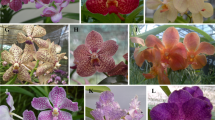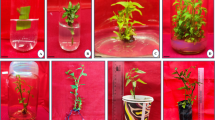Abstract
A protocol was developed for regeneration and Agrobacterium-mediated genetic transformation of Lesquerella fendleri. Calli were first induced from hypocotyls and cotyledons on MS plus 0.5 mg l−1 BA, 1 mg l−1 NAA and 1 mg l−1 2,4-D, then co-cultivated for 2–3 days in darkness on MS supplemented with 0.5 mg l−1 BA, 0.2 mg l−1 NAA and 100 μmol l−1As together with Agrobacterium tumefaciens strain EHA105/pCAMBIA1301 that harbored genes for uidA (GUS) and hygromycin resistance. Following co-cultivation, calli transfected by A. tumefaciens were transferred to MS with 0.5 mg l−1 BA, 0.2 mg l−1NAA, 500 mg l−1 Cef and 10 mg l−1 hygromycin and cultured for 10 days, then the hygromycin was increased to 20 mg l−1 on the same medium. After 4 weeks the resistant regenerants were transferred to MS with 0.5 mg l−1BA, 0.2 mg l−1 NAA, 500 mg l−1 Cef and 25 mg l−1 hygromycin for further selections. Transgenic plants were confirmed by polymerase chain reaction analysis, GUS histochemical assay and genomic Southern blot hybridization. With this approach, the average regeneration frequency from transfected calli was 22.70%, and the number of regenerated shoots per callus was 6–13. Overall results described in this study demonstrate that Agrobacterium-mediated transformation is a promising approach for improvement of this Lesquerella species.




Similar content being viewed by others
Abbreviations
- MS:
-
Murashige and Skoog medium
- NAA:
-
α-Napthaleneacetic acid
- BA:
-
6-Benzylaminopurine
- 2,4-D:
-
2,4-Dichlorophenoxy
- GUS:
-
β-Glucuronidase
- CaMV:
-
Cauliflower mosaic virus
- Hpt:
-
Hygromycin phosphotransferase
- X-Gluc:
-
5-Bromo-4-chloro-3-indolyl-b-d-glucoronide
- PCR:
-
Polymerase chain reaction
- As:
-
Acetosyringone
- Rif:
-
Rifampicin
- Cef:
-
Cefotaxime
References
Arquette JG, Brown JH (1993) Development of a cosmetic grade oil from Lesquerella fendleri L.seed. In: Janick J, Simon JE (eds) New crops. Wiley, New York, pp 367–371
Dierig DA, Thompson AE, Nakayama FS (1993) Lesquerella commercialization efforts in the United States. Ind Crops Prod 1:289–293
Jefferson RA (1987) Assaying chimeric genes in plants: the GUS gene fusion system. Plant Mol Biol Rep 5:387–405
Hajdukiewicz P, Svab Z, Maliga P (1994) The small, versatile pPZP family of Agrobacterium binary vectors for plant transformation. Plant Mol Biol 25:989–994
Holtke HJ, Ankenbauer W, Muhlegger K, Rein R, Sagner G, Seibl R, Walter T (1995) The digoxigenin (DIG) system for non–radioactive labeling and detection of nucleic acids—an overview. Cell Mol Biol 41:883–905
Li D, Sun Q, Huang M, Zhang J, Bai S, Zheng L, Zhao J, Qiu D, Li L, Yang Z, You M, Liu G, Zhang Y, Zhang C, Li S (2006a) Agrobacterium–mediated genetic transformation of Elymus breviaristatus with Pseudomonas pseudoalcaligenes insecticidal protein gene. Plant Cell Tiss Organ Cult DOI: 10.1007/s11240-007-9229-0
Li DX, Zhang J, Zhao J, Zhang Y, Li L, Liu SJ, Chen F, Yang ZR (2006b) Transformation of calli of siberian wildrye grass (Elymus sibiricus L. cv. chuancao No.2) mediated by Agrobacterium. J Plant Physiol Mol Biol 32(1):45–51
Murashige T, Skoog F (1962) A revised medium for rapid growth and bioassays with tobacco tissue cultures. Physiol Plant 15:473–497
Ploschuk EL, Cerdeiras G, Windauer L, Dierig DA, Ravetta DA (2003) Development of alternative Lesquerella species in Patagonia (Argentina): potential of L. angustifolia. Ind Crops Prod 18:1–6
Sambrook J, Russell DW (2002) Molecular cloning: a laboratory manual, 3rd edn. Science Press, Beijing (in Chinese)
Skarzhinskaya M, Landgren M, Glimelius K (1996) Production of intertribal somatic hybrids between Brassica napus L. and Lesquerella fendleri L.(Gray) Wats. Theor Appl Genet 93:1242–1250
Skarjinskaia M, Svab Z, Maliga P (2003) Plastid transformation in Lesquerella fendleri L., an oilseed Brassicacea. Transgenic Res 12:115–22
Thompson AE, Dierig DA, Johnson ER (1989) Yield potential of Lesquerella fendleri L. (Gray) Wats., a new desert plant resource for hydroxy fatty acids. J Arid Environ 16:331–336
Thompson AE, Dierig DA (1994) Initial selection and breeding of Lesquerella fendleri L., a new industrial oil seed. Ind Crops Prod 2:91–106
Author information
Authors and Affiliations
Corresponding author
Rights and permissions
About this article
Cite this article
Wang, W., Wang, C., Huang, BL. et al. Agrobacterium tumefaciens-mediated transformation of Lesquerella fendleri L., a potential new oil crop with rich lesquerolic acid. Plant Cell Tiss Organ Cult 92, 165–171 (2008). https://doi.org/10.1007/s11240-007-9319-z
Received:
Accepted:
Published:
Issue Date:
DOI: https://doi.org/10.1007/s11240-007-9319-z




